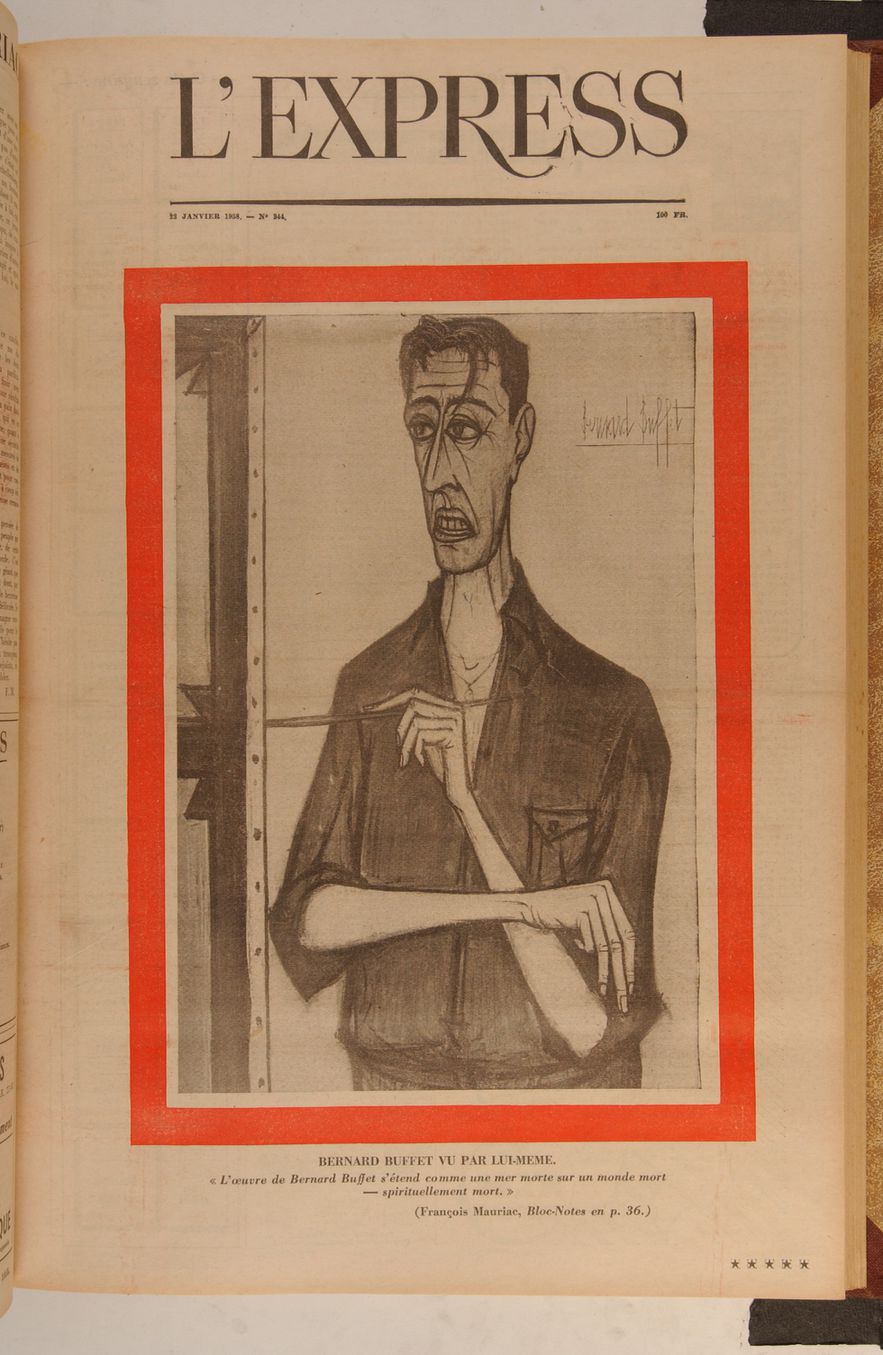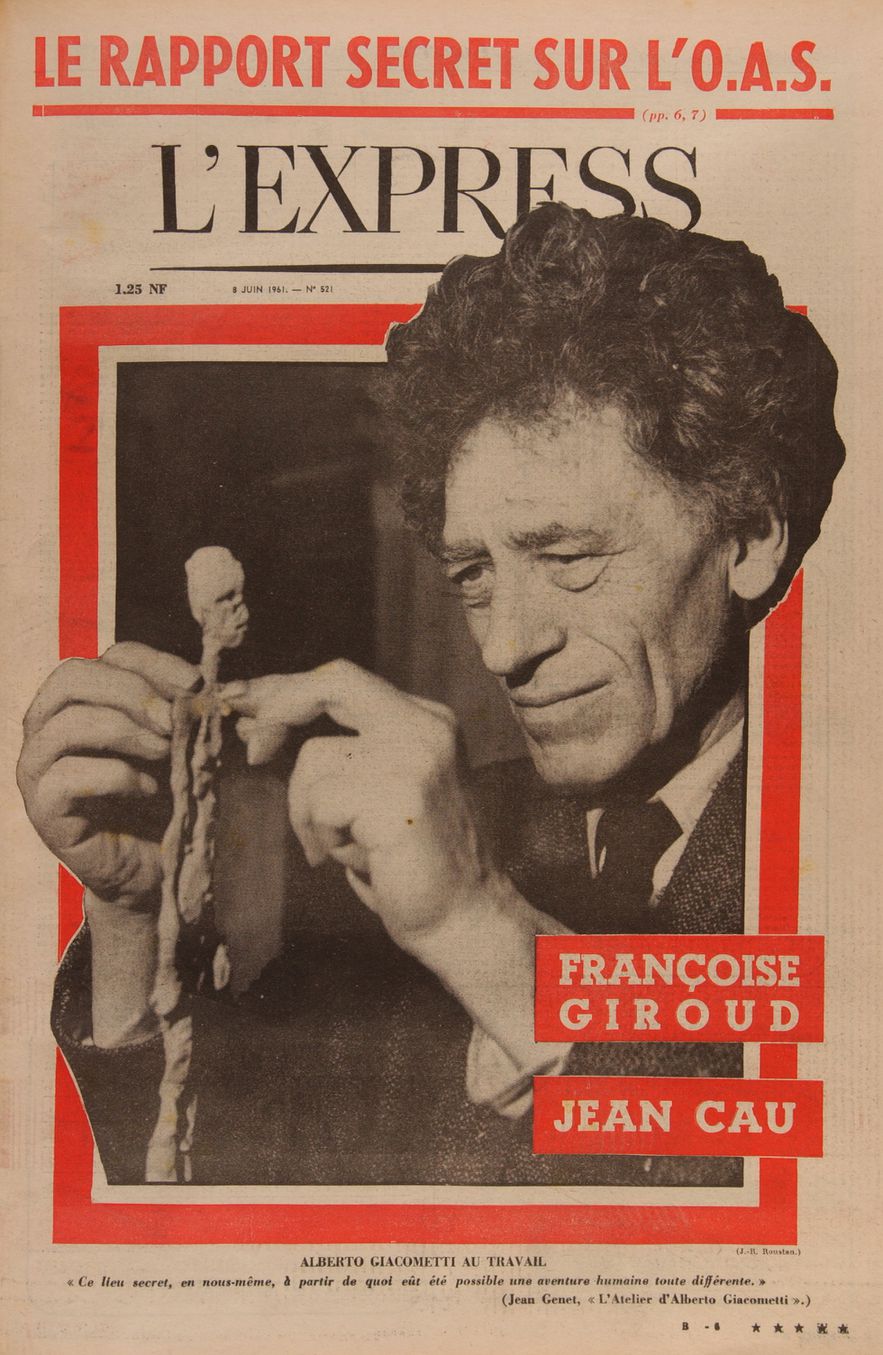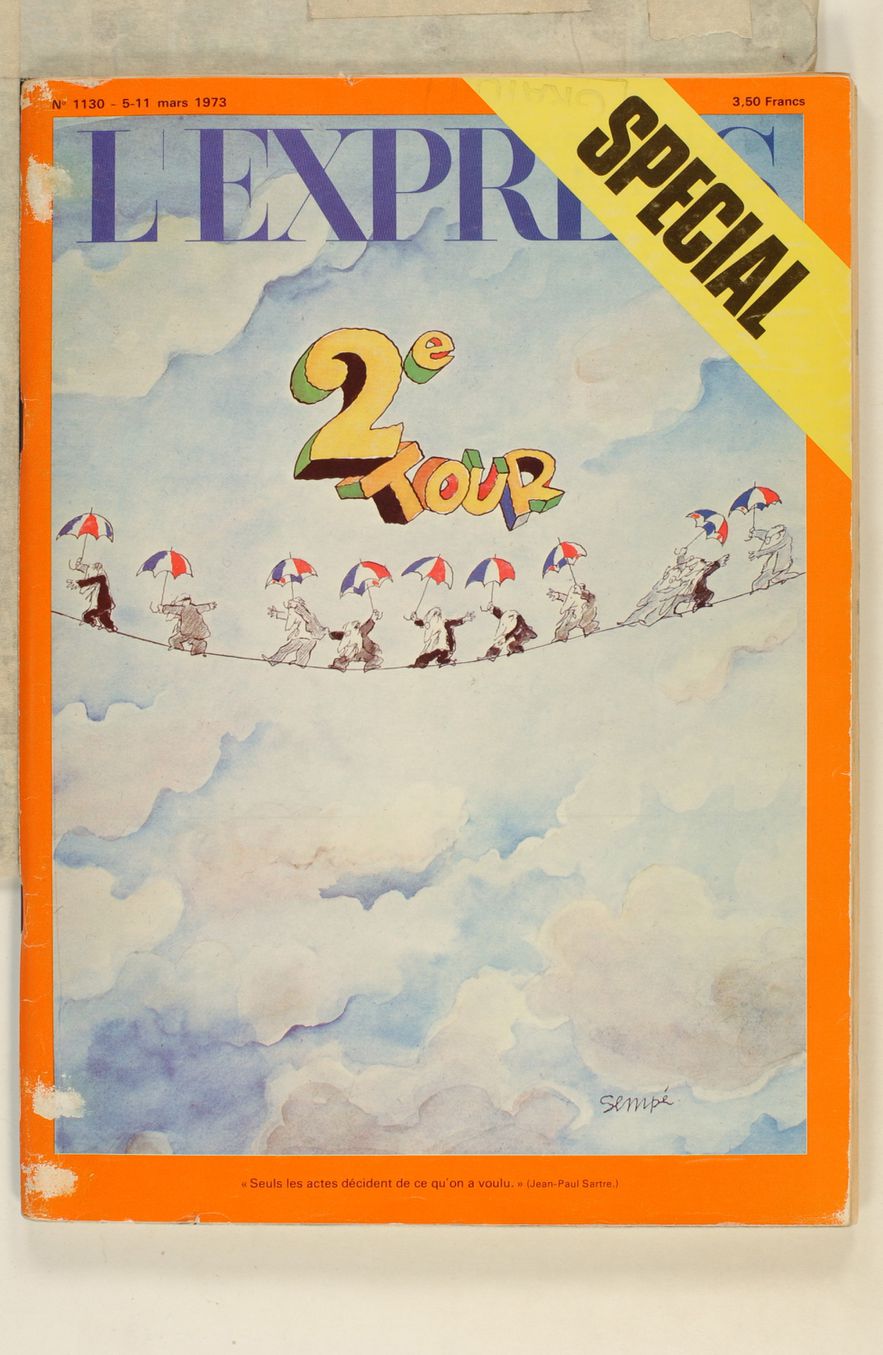As part of its 70th anniversary, L’Express looks back at some key front pages from the weekly which, since its creation in 1953, has maintained a close link with painters, sculptors and designers. From the 1950s to the 1970s, from Pablo Picasso to Jean-Jacques Sempé, via Bernard Buffet, Alberto Giacometti and Victor Vasarely, focus on five covers created for – or by – emblematic artists of their time.
© / The Express
Pablo Picasso, 1957
On November 14, 1957, L’Express put Pablo Picasso, 76 years old, on the front page, with keen eyes and marked wrinkles. A year earlier, he was already on the cover of the magazine, dressed in his famous sailor shirt, announcing an editorial by Jean-François Chabrun on the success of the man who “while being the great fashionable painter, never stopped working against the tide of all fashions”. In this month of November 1957, Hélène Parmelin, art critic at Humanity under the pseudonym Léopold Durand, delivers an exclusive report to L’Express, entitled “Picasso grappling with the Menines”. In the city, she is the wife of the painter of the School of Paris Edouard Pignon and the couple, members of the PCF, are among the intimates of Picasso, who lives with Jacqueline Roque.

The front page of November 14, 1957.
/ © Archives L’Express
Hélène and Edouard then stayed at the Villa Californie in Cannes, where Pablo struggled to give birth to his Meninas : a series of variations which reinterpret Velázquez’s flagship work, Las Meninas, a complex and enigmatic family portrait (that of Philip IV) from 1656, where the Baroque painter depicts himself with a palette in his hand behind the main characters, while the king and queen are, in the background, reflected in a mirror. For Picasso, the reinterpretation of such a painting is akin to the Stations of the Cross, as he confided to a reporter during a bullfight: “What a terrible story! We always believe that making a painting is making paint… And yet, it’s worse than being killed!”
Bernard Buffett, 1958
“The work of Bernard Buffet extends like a dead sea over a dead world – spiritually dead.” This sentence from François Mauriac subtitles the front page that Buffet offered to L’Express on January 23, 1958, representing himself, sharp features and paintbrush in hand (left). On page 36, the writer Mauriac put the painter Buffet in the spotlight of his famous Bloc-Notes, where, every week, he “comments freely on political and literary news”. He reports on the opening of the artist’s exhibition, on the 19th, at the Charpentier gallery. “There was a crowd,” he explains, before wondering: “Confronted with Bernard Buffet’s painting, did she recognize herself?” Then he immediately launches into an analysis of abstraction (we are in 1958): “Abstract painters had exempted this generation from knowing what it looked like: they had blurred the image.”

Front page of January 23, 1958.
/ © Archives L’Express
Here, under the author’s pen, Bernard Buffet propelled “wise young man”, salutarily figurative, opposed to a Picasso that Mauriac does not fail to evoke as the one of whom it is said that he is “the devil”. Enthusiastic about the works of the angel Buffet, Mauriac burst into flames: “He puts Picasso’s world back together. The world, our world, is recomposed in this painting.” Two weeks later, on February 6, L’Express reproduced on its cover a drawing by Buffet from the Yves Saint Laurent collection, the line of the illustrious house as he sees it. The sketch was specially designed for L’Express readers. And the following year, on January 1, 1959, the artist did it again with a striking portrait of De Gaulle, the great man who returned to power the previous year. No doubt, Bernard Buffet is in cahoots with L’Express.
Alberto Giacometti, 1961
In this year 1961, Pierre Schneider, an art historian respected by his peers, has been a columnist for L’Express since the beginning of the weekly; he will remain so until 1993. The articles of this close friend of the artists are very popular with readers. On June 8, 1961, it was Alberto Giacometti who was in his sights. On the front page, the sculptor is “at work”. The following article, entitled “My long walk”, is part of the debate, predominant at the time, of the abstract-figurative squabble. In his tiny workshop in the 14th arrondissement of Paris, Giacometti confides in Schneider: “Isn’t this face that you are looking for which is behind every particular face general to the point of being abstract?” the latter asks him. “Ah! no. Absolutely the opposite. The more you are, the more you become anyone… But you are only others by being yourself as much as possible, aren’t you?”, replies Tit for tat artist.

The front page of June 8, 1961.
/ © Archives L’Express
At the time, Alberto Giacometti was turning 60 and was having a passionate affair with a young 23-year-old prostitute, Caroline, whom he met in a bar and of whom he painted numerous portraits. Despite his worldwide fame, through his merchants Aimé Maeght and Pierre Matisse – Henri’s son –, he lived modestly and was unaware that he would die less than five years later from pericarditis. At the end of his interview with Pierre Schneider, while the exchange still focuses on non-figuration, the master of statuary blurts out: “Art interests me a lot, but the truth interests me infinitely more… More I work, the more I see differently.”
Victor Vasarely, 1967
On November 6, 1967, L’Express pulled off a nice coup: the creation of the front page by the father of Op Art, on the occasion of the fiftieth anniversary of the Russian Revolution. At 61 years old, Victor Vasarely complies with the exercise all the more easily because having worked for many years in advertising graphics, the demands of the model are familiar to him. Another constraint imposed by the newspaper: the use of the symbol of the Revolution on the cover. This is how the sickle and the hammer appear on the front page, the first of the two symbols being transformed into a question mark. This punctuation mark “is not addressed to Russia, but to the idea of revolution. It is linked to Che Guevara’s last manifesto, to Greece…”, the artist confides to the art critic of L’ Express, Otto Hahn, asking: “Why this failure in South America, this contradiction between the USSR and China?”

The front page of November 6, 1967.
/ © Archives L’Express
Far from a bohemian struggling at his easel, Vasarely is a true business leader who has fully entered the technological era. He imagines, his team realizes. To Otto Hahn, the master explains that he spent twelve hours designing the cover, which also required sixty hours of work in the workshop. If the painter is popular – his paintings reach 70,000 francs – he asked the newspaper to pay him, for this collaboration, the fees of a simple photographer: “Although I benefit from it, I am against the system which consists of skyrocketing the prices of an artist based on criteria as fragile as fashion, the decision of an elite…”
Jean-Jacques Sempé, 1973
With his round face and wide azure eyes, he carried his disenchanted poetry to Parisian editorial offices for a long time. From 1965, it was L’Express which was favored by Jean-Jacques Sempé and his miniature figures lost in the middle of the infinitely large. Hired by Françoise Giroud to scrutinize “modern life”, he wrote in the columns of the newspaper for almost ten years, before being fired by Jean-Jacques Servan-Schreiber. JJSS is much less sensitive than his colleague to the humor, sometimes cowardly, of the designer.

The front page of March 5, 1973.
/ © Archives L’Express
On March 5, 1973, the day after the first round of the legislative elections, Sempé announced, on the front page of the 1130th issue of the weekly, the second ballot of the election with a cohort of small characters who parade, in a perilous balance, on a wire heavenly, sheltered by tricolor umbrellas. He intends to sketch the fragility of the candidates after this interminable “night of ballotages”, recounted, page 48, by the editor-in-chief of the France section, Guy Claisse. While, under the designer’s work, an explicit quote from Sartre, “Only actions decide what we wanted”, serves as a subtitle.
For the father of Little Nicholas, a relentless and anxious worker of the blank page, the press cartoon is akin to both paradise and hell. “You have to produce the maximum effect with a minimum of means. I can stay for whole days at my table scribbling, waiting for the idea to come,” he confided to L’Express in 2019, three years old before joining the clouds.
For its 70th anniversary, L’Express is organizing an exceptional conference on Wednesday October 18 on emblematic themes of the newspaper: politics, science, climate, Europe… An afternoon of debates of ideas, exchanges and shared perspectives to understand today’s world and project ourselves into the next 70 years in the company of great visionaries including Bill Gates (in video), Francis Fukuyama, and many other high-level French and international experts! Discover the program
